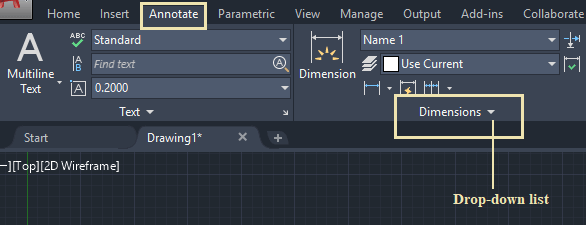
AutoCAD, the industry-leading computer-aided design (CAD) software developed by Autodesk, offers a multitude of powerful tools and commands for creating precise and detailed drawings. Among these tools, the DIMENSION command stands out as a fundamental feature for adding accurate dimensions to drawings, facilitating clear communication and understanding of design intent. In this comprehensive guide, we delve deep into the intricacies of using the DIMENSION command in AutoCAD, exploring various methods, techniques, and best practices for optimal utilization.
Understanding Dimensioning in AutoCAD:
Dimensioning in AutoCAD refers to the process of adding linear, angular, radial, and diametric dimensions to drawings to convey size, distance, and geometric relationships between objects. Dimensions provide critical information for fabrication, construction, and inspection processes, ensuring accuracy and compliance with design specifications. The DIMENSION command in AutoCAD allows users to create and customize dimension objects with precision, including options for dimension type, style, alignment, and placement.
Using the DIMENSION Command:
AutoCAD offers multiple methods for using the DIMENSION command to create and customize dimension objects in drawings:
1. Linear Dimensions:
The DIMENSION command allows users to create linear dimensions to indicate distance measurements between two points or along an object. To create linear dimensions, follow these steps:
- Type “DIMENSION” in the command line and press Enter to activate the DIMENSION command.
- Specify the first and second extension line origins by clicking on the object endpoints or selecting points in the drawing area.
- Position the dimension line by clicking to place the dimension text.
- Optionally, specify additional options such as dimension style, text height, and precision.
2. Angular Dimensions:
AutoCAD also supports the creation of angular dimensions to indicate the angle between two lines or objects. To create angular dimensions, follow these steps:
- Activate the DIMENSION command and select the Angular option.
- Specify the vertex point by clicking on the intersection of the lines or selecting the vertex in the drawing area.
- Position the dimension text by clicking to place it in the desired location.
- Optionally, specify additional options such as dimension style, text height, and precision.
3. Radial and Diametric Dimensions:
In addition to linear and angular dimensions, AutoCAD allows users to create radial and diametric dimensions to indicate the radius or diameter of circles and arcs. To create radial or diametric dimensions, follow these steps:
- Activate the DIMENSION command and select the Radial or Diametric option.
- Click on the arc or circle to specify the dimension origin point.
- Position the dimension text by clicking to place it in the desired location.
- Optionally, specify additional options such as dimension style, text height, and precision.
Key DIMENSION Command Options:
When using the DIMENSION command in AutoCAD, users can specify various options and parameters to customize dimension objects according to their requirements. Key options include:
- Dimension Style: Choose from a predefined set of dimension styles or create custom dimension styles with specific settings such as text height, arrowhead style, and dimension lines.
- Text Height: Specify the height of dimension text in drawing units, controlling its size and visibility relative to the drawing scale.
- Arrowheads and Symbols: Select arrowhead styles and symbols for dimension lines, including options for closed or open arrows, architectural ticks, and custom symbols.
- Precision and Tolerance: Define precision settings and tolerance values for dimension measurements, ensuring accuracy and consistency in dimensioning.
Advanced Techniques:
In addition to basic dimensioning methods, AutoCAD offers advanced techniques and tools for enhancing dimension objects and efficiency:
- Associative Dimensions: Create associative dimensions that maintain dynamic links to object geometry, updating automatically when the associated objects are modified or moved.
- Baseline and Continued Dimensions: Use baseline and continued dimensioning tools to create multiple dimensions aligned with a common baseline or reference dimension, streamlining the dimensioning process for complex drawings.
- Dimension Styles and Templates: Define and manage dimension styles and templates using the DIMSTYLE command, allowing for consistent formatting and appearance of dimension objects across multiple drawings and projects.
- Dimension Editing: Edit existing dimension objects using AutoCAD’s editing tools, such as grips, handles, and dimension properties, to modify text content, style, and placement as needed.
Best Practices:
To achieve optimal results when using the DIMENSION command in AutoCAD, it’s essential to adhere to the following best practices:
- Plan and Organize: Before creating dimension objects, carefully plan the dimensioning scheme, considering the required dimensions, placement, and formatting for clear communication and understanding.
- Use Consistent Styles: Maintain consistency in dimension styles, including text height, arrowhead style, and dimension lines, throughout the drawing to ensure uniformity and professionalism in presentation.
- Optimize Dimension Placement: Place dimension objects strategically to avoid clutter and confusion, ensuring sufficient spacing and alignment for readability and visual clarity.
- Utilize Associativity: Take advantage of associative dimensions to maintain dynamic links to object geometry, facilitating automatic updates and revisions as the design evolves.
- Review and Verify: Review dimension objects for accuracy, completeness, and clarity before finalizing drawings, verifying measurements and tolerances to ensure compliance with design specifications.
Conclusion:
In conclusion, mastering the DIMENSION command in AutoCAD empowers designers and drafters to add accurate and clear dimensioning to drawings with precision and efficiency. By understanding the various methods, options, and best practices for using the DIMENSION command, users can create dimension objects that enhance communication, clarity, and professionalism in their drawings and designs. With AutoCAD’s versatile tools and features, designers can achieve precise and effective representation of dimensional information, ensuring accuracy and compliance with design standards and specifications.